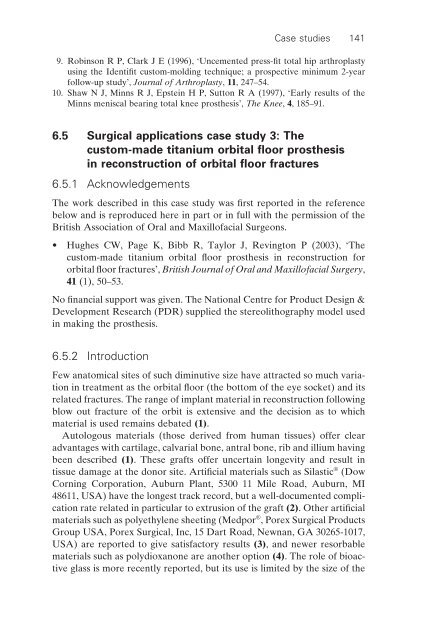R_Bibb_Medical_Modelling_The_Application_of_Adv.pdf
R_Bibb_Medical_Modelling_The_Application_of_Adv.pdf
R_Bibb_Medical_Modelling_The_Application_of_Adv.pdf
Create successful ePaper yourself
Turn your PDF publications into a flip-book with our unique Google optimized e-Paper software.
Case studies 141<br />
9. Robinson R P, Clark J E (1996), ‘Uncemented press-fi t total hip arthroplasty<br />
using the Identifi t custom-molding technique; a prospective minimum 2-year<br />
follow-up study’, Journal <strong>of</strong> Arthroplasty, 11, 247–54.<br />
10. Shaw N J, Minns R J, Epstein H P, Sutton R A (1997), ‘Early results <strong>of</strong> the<br />
Minns meniscal bearing total knee prosthesis’, <strong>The</strong> Knee, 4, 185–91.<br />
6.5 Surgical applications case study 3: <strong>The</strong><br />
custom-made titanium orbital fl oor prosthesis<br />
in reconstruction <strong>of</strong> orbital fl oor fractures<br />
6.5.1 Acknowledgements<br />
<strong>The</strong> work described in this case study was fi rst reported in the reference<br />
below and is reproduced here in part or in full with the permission <strong>of</strong> the<br />
British Association <strong>of</strong> Oral and Maxill<strong>of</strong>acial Surgeons.<br />
• Hughes CW, Page K, <strong>Bibb</strong> R, Taylor J, Revington P (2003), ‘<strong>The</strong><br />
custom-made titanium orbital fl oor prosthesis in reconstruction for<br />
orbital fl oor fractures’, British Journal <strong>of</strong> Oral and Maxill<strong>of</strong>acial Surgery,<br />
41 (1), 50–53.<br />
No fi nancial support was given. <strong>The</strong> National Centre for Product Design &<br />
Development Research (PDR) supplied the stereolithography model used<br />
in making the prosthesis.<br />
6.5.2 Introduction<br />
Few anatomical sites <strong>of</strong> such diminutive size have attracted so much variation<br />
in treatment as the orbital fl oor (the bottom <strong>of</strong> the eye socket) and its<br />
related fractures. <strong>The</strong> range <strong>of</strong> implant material in reconstruction following<br />
blow out fracture <strong>of</strong> the orbit is extensive and the decision as to which<br />
material is used remains debated (1).<br />
Autologous materials (those derived from human tissues) <strong>of</strong>fer clear<br />
advantages with cartilage, calvarial bone, antral bone, rib and illium having<br />
been described (1). <strong>The</strong>se grafts <strong>of</strong>fer uncertain longevity and result in<br />
tissue damage at the donor site. Artifi cial materials such as Silastic ® (Dow<br />
Corning Corporation, Auburn Plant, 5300 11 Mile Road, Auburn, MI<br />
48611, USA) have the longest track record, but a well-documented complication<br />
rate related in particular to extrusion <strong>of</strong> the graft (2). Other artifi cial<br />
materials such as polyethylene sheeting (Medpor ® , Porex Surgical Products<br />
Group USA, Porex Surgical, Inc, 15 Dart Road, Newnan, GA 30265-1017,<br />
USA) are reported to give satisfactory results (3), and newer resorbable<br />
materials such as polydioxanone are another option (4). <strong>The</strong> role <strong>of</strong> bioactive<br />
glass is more recently reported, but its use is limited by the size <strong>of</strong> the
















